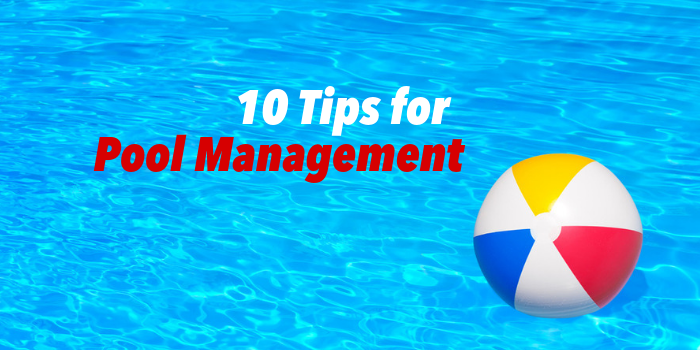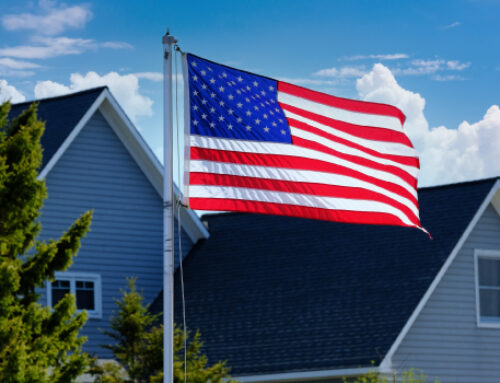Summer is an exciting time in any community—kids are out of school, the weather is perfect for barbecues and snow cones, and families are looking for ways to keep cool. That’s where the community pool comes in.
As a board member, you want to do everything you can to make sure your homeowners have fun and stay safe at the community pool. To help you with this goal, we reached out to Seven Wells Pool Management for some advice. Below are 10 tips for pool management and maintenance based on their 14 years of experience.
Tips for Pool Management
- Teach your pool patrons how to be safe. First, your association should establish pool rules and file them with the county. After the document is filed, you can enforce rules that are key to homeowners’ safety and deny access to those who create dangerous situations. Safety reminders can be included in community newsletters and shared during community meetings. A pool waiver can also be used as a reminder of the pool patrons’ responsibility in their own safety.
Lastly, your association can educate homeowners to improve pool safety by offering swim lessons at the pool, hosting a community swim team, and promoting or requiring the use of coastguard-approved flotation devices for non-swimmers.
- Hire lifeguards and attendants (if financially feasible). American Red Cross certified lifeguards have proven their skill in responding to emergency situations. By rotating lifeguards and keeping their shifts short, you can help ensure their vigilance is at its peak. Long hours under a hot sun can be draining on anyone. Pool facility attendants work to make sure that no trespassers enter the pool facility and that unsafe items, such as roller skates and scooters, alcohol, glass, and the like, are not brought into the pool area. If lifeguards and attendants don’t fit in your association’s budget, pay particularly close attention to our other suggestions to improve safety at your community pool.
- Post proper signage. In particular, posting a sign that states “No lifeguard on duty. Children should not use the pool without adult supervision.” will help pool patrons be aware of risks and prepare for them accordingly. Your HOA should also post a sign that lists pool rules, which will provide the dos and don’ts of pool safety. These measures will also prevent the HOA from being exposed to unnecessary liability due to inadequate signage.
- Light and secure the pool facilities. If your community pool is open at night, sufficient lighting will keep homeowners and guests from tripping in the dark. A well-lit pool with surveillance cameras can also dissuade trespassers. Additionally, proof your pool facilities for any spots where trespassers could easily gain access by climbing over or slipping underneath/through the fence. Check that the facilities remain locked when closed and that the gate is not propped open during daytime hours.
Tips for Pool Maintenance
- Empty pool baskets regularly. Both poolside baskets and strainer baskets can become clogged with leaves, hair, and lint that will choke the pool system’s pump and cause premature failure.
- Service pool filter media every three to five years (based on pool usage). If this media is not regularly changed, pool water will become cloudy and excessive dirt will accumulate on the pool floor between cleanings. You can also experience premature pump failure and find that correct chlorine levels are ineffective in keeping water clean.
- Evaluate pool plaster every 10 years (or more frequently in pools with high usage). If water chemistry is out of balance or if chemicals are overused, plaster can become abrasive and pitted. This can cause safety concerns such as pool toe, minor cuts, and abrasions.
- Check for water loss due to missing tiles and cracks each year. These should be addressed quickly to avoid more serious issues of ground movement and pool structure damage. A report of effective solutions should be created by pool maintenance and given to the board.
- Keep pool water fresh. The water in your community pool should make one complete cycle through the filters every six to eight hours, depending on pool usage. Backwash filters twice a month during the summer and once a month during the off season, and vacuum pool waste directly into the drain. These measures help ensure that water conditions remain within acceptable levels (30-70 PPM) and dissolved solids are kept under control. Some pools may need to be drained every three to five years to keep water fresh.
- Choose your pool maintenance company carefully. Like all vendors contracted by your HOA, a pool management company should carry their own liability and workers compensation insurance. In addition, check that the company is a Certified Pool Operator (CPO). A community or commercial pool specialization will also work to ensure high standards, as many residential pool maintenance companies might not meet all the safety requirements we have discussed above. Reading Google reviews and taking references from applicants are other steps you can take to find the best quality pool service.
Thanks for joining us. We hope this information helps you make your community pool the best it can be! For more HOA management tips, be sure to check out our blog for weekly updates.







